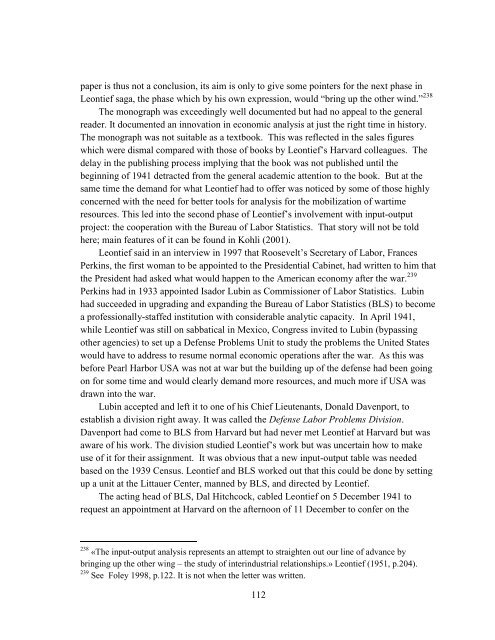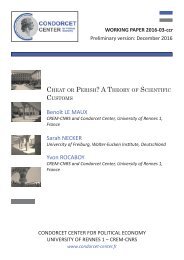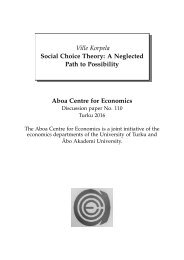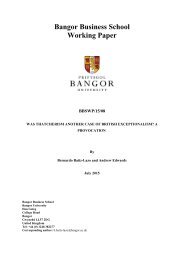MEMORANDUM
n?u=RePEc:hhs:osloec:2016_018&r=hpe
n?u=RePEc:hhs:osloec:2016_018&r=hpe
You also want an ePaper? Increase the reach of your titles
YUMPU automatically turns print PDFs into web optimized ePapers that Google loves.
paper is thus not a conclusion, its aim is only to give some pointers for the next phase in<br />
Leontief saga, the phase which by his own expression, would “bring up the other wind.” 238<br />
The monograph was exceedingly well documented but had no appeal to the general<br />
reader. It documented an innovation in economic analysis at just the right time in history.<br />
The monograph was not suitable as a textbook. This was reflected in the sales figures<br />
which were dismal compared with those of books by Leontief’s Harvard colleagues. The<br />
delay in the publishing process implying that the book was not published until the<br />
beginning of 1941 detracted from the general academic attention to the book. But at the<br />
same time the demand for what Leontief had to offer was noticed by some of those highly<br />
concerned with the need for better tools for analysis for the mobilization of wartime<br />
resources. This led into the second phase of Leontief’s involvement with input-output<br />
project: the cooperation with the Bureau of Labor Statistics. That story will not be told<br />
here; main features of it can be found in Kohli (2001).<br />
Leontief said in an interview in 1997 that Roosevelt’s Secretary of Labor, Frances<br />
Perkins, the first woman to be appointed to the Presidential Cabinet, had written to him that<br />
the President had asked what would happen to the American economy after the war. 239<br />
Perkins had in 1933 appointed Isador Lubin as Commissioner of Labor Statistics. Lubin<br />
had succeeded in upgrading and expanding the Bureau of Labor Statistics (BLS) to become<br />
a professionally-staffed institution with considerable analytic capacity. In April 1941,<br />
while Leontief was still on sabbatical in Mexico, Congress invited to Lubin (bypassing<br />
other agencies) to set up a Defense Problems Unit to study the problems the United States<br />
would have to address to resume normal economic operations after the war. As this was<br />
before Pearl Harbor USA was not at war but the building up of the defense had been going<br />
on for some time and would clearly demand more resources, and much more if USA was<br />
drawn into the war.<br />
Lubin accepted and left it to one of his Chief Lieutenants, Donald Davenport, to<br />
establish a division right away. It was called the Defense Labor Problems Division.<br />
Davenport had come to BLS from Harvard but had never met Leontief at Harvard but was<br />
aware of his work. The division studied Leontief’s work but was uncertain how to make<br />
use of it for their assignment. It was obvious that a new input-output table was needed<br />
based on the 1939 Census. Leontief and BLS worked out that this could be done by setting<br />
up a unit at the Littauer Center, manned by BLS, and directed by Leontief.<br />
The acting head of BLS, Dal Hitchcock, cabled Leontief on 5 December 1941 to<br />
request an appointment at Harvard on the afternoon of 11 December to confer on the<br />
238 «The input-output analysis represents an attempt to straighten out our line of advance by<br />
bringing up the other wing – the study of interindustrial relationships.» Leontief (1951, p.204).<br />
239 See Foley 1998, p.122. It is not when the letter was written.<br />
112





